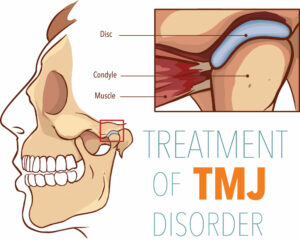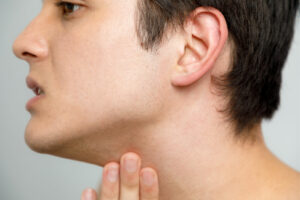What Causes Jaw Pain or TMJ?
If you are experiencing Jaw Pain, it may be due to a condition called TMJ. Do you have headaches, ringing in your ear, or is your hearing muffled? Or maybe you have jaw pain, clicking, or popping with chewing, singing, or yawning. We treat disorders of the temporomandibular joint (TMJ), which refers to the joints on either side of your Jaw. When you clench your teeth, you can feel the TMJ muscles tighten by placing your hand on your Jaw, just below your ears.

The unique thing about the TMJs is that they are the only pair of joints that must work in synchronicity. Dysfunction on one side will affect the movement of the other side. The temporal bone of your skull has a round concave indention called the mandibular fossa. This “socket” is where the condyle, or “ball” of the lower jaw bone (mandible) fits and rotates. The ear canal is very close to the TMJ and that is why you can have ear pain or ringing of the ears. There is a disc between the mandibular condyle and the mandibular fossa, and ligaments help hold the disc in place, as well as limiting its movement. There is an anterior band of ligamentous tissue at the front and the back of the disc that attach to muscle and that attach the disc to the bone that keeps it in place. The disc and joint are enclosed in a joint capsule and surrounded by synovial fluid to nourish and lubricate the disc and joint. There are also ligaments along the inside and outside sides of the TMJ.
Pain and movement problems occur when the surrounding ligaments and the muscles of chewing get inflamed. Key factors that affect TMJ function are posture and stress and changes in the position of the teeth (bruxism).

Poor posture can contribute to TMJ pain
Have ever seen a picture of yourself from the side and see that your head is forward of your shoulders (forward head posture)? This posture can cause headaches and neck pain from the back to the front of your head and cause the muscles around the jaw function incorrectly leading to pain. Very often the headaches from this are wrongly assumed to be “sinus headache” because where the headache pain is felt in the front of the face.
Can anything be done to help with TMJ pain? Yes! We start by assessing your neck to see if your posture is affecting your jaw biomechanics, or if your neck is contributing to neck, face pain and headaches. We can check your TMJ itself and determine if the joint or muscles or both are contributing to your symptoms.
PoFirst assess where the pain in coming from
Based on careful evaluation we develop a treatment plan customized to your individual needs. Some of the techniques may include manual therapy, dry needling to trigger points in the neck and jaw (masticatory) muscles, exercises to retrain your jaw biomechanics and posture, and modalities such as ultrasound or electrical stimulation to ease your symptoms. We can also help you become aware of and self-monitor for unconscious behaviors, you have in daily habits that contribute to jaw pain. At Lee Miller Rehab Associates, we can help you determine if your neck, or jaw, or both can be helped with physical therapy.
Consider calling to see if you qualify for a free screening of your jaw and neck at Lee Miller Rehab Associates.
